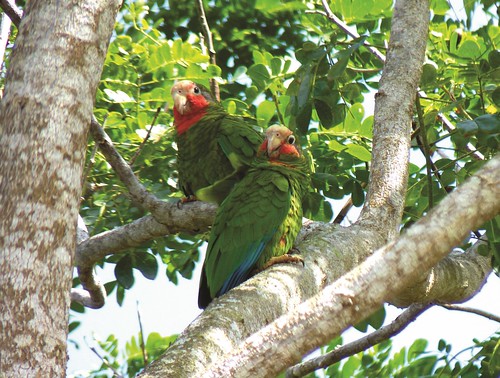 Cayman Parrots Photo by Stuart MailerThe sight of a pair of Cayman parrots is a familiar one to many Caymanians. You are more likely to hear the raucous squawking of the National Bird of the Cayman Islands before actually seeing one, especially in the early morning and late afternoon when they are most vocal. When feeding quietly in the tops of trees, they are so well camouflaged you may never realise they are there.
Cayman Parrots Photo by Stuart MailerThe sight of a pair of Cayman parrots is a familiar one to many Caymanians. You are more likely to hear the raucous squawking of the National Bird of the Cayman Islands before actually seeing one, especially in the early morning and late afternoon when they are most vocal. When feeding quietly in the tops of trees, they are so well camouflaged you may never realise they are there.
The Cayman Islands’ parrots are, in fact, two subspecies of the Cuban Parrot (Amazona leucocephala). Both subspecies are endemic to the Cayman Islands – which means they are found nowhere else in the world. In fact, there are only three other subspecies of this parrot in the world – two in Cuba and one in the Bahamas. Cayman’s parrots have iridescent green feathers with darker edges over the body, a white eye ring, red cheeks, black ear patches and brilliant blue wing feathers which are only obvious when the bird is in flight. The tail has blue outer edges, with some red and yellowish green underneath.
The Grand Cayman Parrot (Amazona leucocephala caymanensis) in particular, has a pink flush to its whitish forehead. The male is slightly larger and more brightly coloured than the female. Juvenile birds have yellowish foreheads, gradually becoming more washed with pink as they mature.
Cayman Brac Parrot
The Cayman Brac Parrot (Amazona leucocephala hesterna) is slightly smaller, with more black trim on its green feathers. The crown is pure white, and there is a large maroon area on the abdomen. It is now found only on Cayman Brac: although it used to inhabit Little Cayman it was apparently wiped out from there in the great storm of 1932. The Cayman Brac Parrot has the smallest range of any Amazon parrot and so is one of the rarest.
The Cayman Islands’ parrots feed on Sea Grapes, Red Birch berries and the flowers, seeds and berries of many other native plants. They are usually seen in pairs or small family groups, and are most active in the early morning or just before sunset. They have a wide range of different calls, some only used in particular contexts, such as while in flight, when alarmed, or when advertising their position to other parrots. Larger flocks will sometimes gather, especially just before the breeding season. The Cayman Brac Parrot is quieter, has different calls and is very secretive. It is rarely seen in winter, and has earned the nickname the “Stealth Parrot”.
Cayman’s parrots mate for life, and use the same nesting sites over and over again. They nest in rural areas, either mangrove or dry forest, in hollow trees, laying between one and five eggs every spring. The eggs hatch after about 24 days, and the young remain in the nest for about eight weeks and are able to fly by mid-summer.
Those who often see flocks of parrots in the wild may wonder why the Cayman Islands’ parrots are protected. It must be remembered that they are only found in the Cayman Islands, and so healthy local populations must be maintained if these unique birds are to survive.
For more information or to arrange a bird watching tour please call the National Trust at 749-1121 or email education@nationaltrust.org.ky